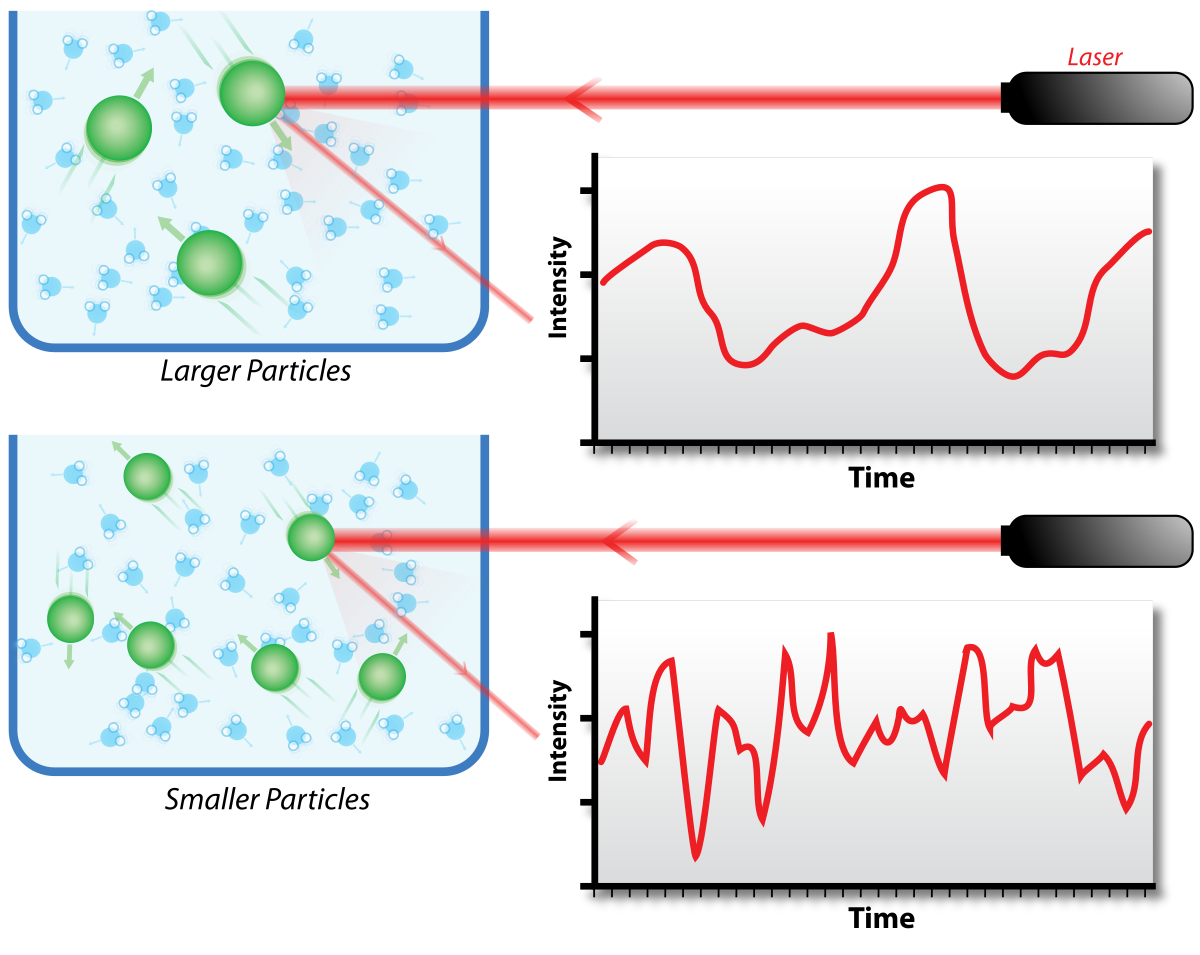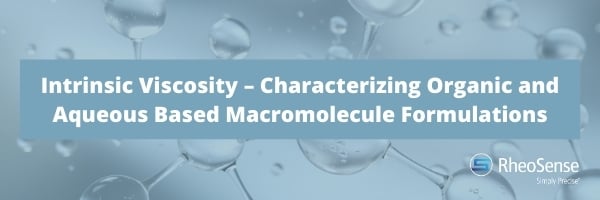The first light scattering experiment was conducted in 1868, but it wasn’t used for molecular characterization until after 1969 when E.R Pike and his co-workers established the relationship between light scattering and diffusion behavior of particles.¹
Dynamic Light Scattering (DLS) is a parameter - like viscosity - that uses light to determine the size distribution profile of particles in a solution. This is primarily done through the measurement of the Brownian motion of macromolecules in the solution caused by the addition of solvent molecules to the solution. Because Brownian motion depends on macromolecule size, temperature and solvent viscosity, temperature is essential for DLS measurements.² 
While DLS is a commonly used method for determining macromolecule size, at RheoSense, we focus more on intrinsic viscosity. We talk a lot about the theory behind intrinsic viscosity calculations and the relationship to molecular properties. We also focus a lot of attention around how to use automated viscosity measurements to perform the calculations and how to apply intrinsic viscosity measurements to your data and analysis. This focus on intrinsic viscosity is because it is a means to understand molecular structure and its interaction in solution.

Measurement of this parameter is considered to be a more reliable method than light scattering. Specifically, intrinsic viscosity can measure lower molecular weight. Using an empirical model known as the Mark-Houwink-Sakurada relation, intrinsic viscosity correlates to the size of the macromolecules:
[n]=KMª
Where K and a are constants for a given combination of macromolecule and solvent varying with temperature and molecular weight range.Therefore, molecular weight or size (M) can be calculated from the intrinsic viscosity value.
When you apply the readings of DLS you are able to determine the diffusion coefficient (kD), which can be used to determine hydrodynamic radius and protein-protein interaction (PPI) within your solution. According to technical details, there are different "groups of kD", which is how PPI is assigned. However, DLS measurement applications have proven to be rather flawed because kD values are actually difficult to get with current methods. Many DLS systems will have a “viscosity” measurement that’s provided on the side, however, because DLS doesn’t focus on viscosity, the measurements can be extremely inaccurate and having inaccurate viscosity measurements would lead to inaccurate calculations for DLS (size distribution of particles in solutions).
When we look at a comparison of kD vs. intrinsic viscosity, both are non-invasive measurement techniques that provide characterization across a wide range of temperature and concentrations. However, if you use intrinsic viscosity, there is a two step process, which helps verify that your process is correct and more accurate. DLS also requires temperature for your experiments be kept constant and that solvent viscosity be accurately measured and known. DLS is also restricted to transparent sample preparation and often can’t distinguish closely related molecules.¹
On the other hand, intrinsic viscosity is a reliable and sensitive indicator of a solute’s molecular interaction with a solvent, and can be used to determine the molecular properties of a sample, such as:
- Molecular weight and size
- Polymerization
- Interaction of molecules
- Degradation
- Branching structure
- Stability of molecules: aggregation, denaturation, or conformational changes of protein molecules
- Protein structure and melting temperatures
What may be the most differentiating feature of RheoSense patented VROC® powered viscometers is their exceptional repeatability (0.5% of reading) and accuracy (2%), which makes them the only viscometers available today with the necessary capabilities to provide intrinsic viscosity measurements. Hence, a lot of customers who have DLS systems also purchase a RheoSense viscometer to use as a more accurate solution!
Want to learn more about intrinsic viscosity? Download our webinar recording: Intrinsic Viscosity – Characterizing Organic and Aqueous Based Macromolecule Formulations.
In this webinar, you will learn:
- The theory behind intrinsic viscosity calculations and the relationship to molecular properties
- How to use automated viscosity measurements to perform the calculations
- Benefits of measuring and analyzing dilute solution viscosity
Written by: Eden Reid, RheoSense Senior Marketing Associate
- J Stetefeld, SA McKenna, TR Patel. Dynamic light scattering: a practical guide and applications in biomedical sciences. Biophys Rev. 2016 Oct 6. doi: 10.1007/s12551-016-0218-6 [NCBI]
- Foord R, Jakeman E, Oliver CJ, Pike ER, Blagrove RJ, Wood E, Peacocke AR. Determination of diffusion coefficients of haemocyanin at low concentration by intensity fluctuation spectroscopy of scattered laser light. Nature. 1970;227:242. doi: 10.1038/227242a0. [NCBI]
- Harding SE, Jumel K. Light scattering. In: Coligan JE, Dunn BM, Ploegh HL, Speicher DW, Wingfield PT, editors. Current protocols in protein science. New York: John Wiley & Sons, Inc.; 1998. [NCBI]


